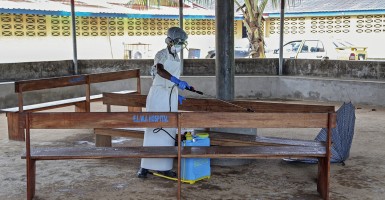For most Americans, last year’s Ebola outbreak was a public health concern and cause for a debate over infectious disease practices, safety and travel.
For West Africans, it was a real-life crisis with deaths in the thousands and desperate efforts to keep it from spreading.
But for those tasked with developing the response for it here and abroad, it was an education not only in disease fighting but in coalition building and knowledge gathering. That was the main takeaway from a panel discussion on Ebola and the American response Tuesday at The Heritage Foundation.
“Ebola is not gone today,” said Carmen J. Spencer, joint program executive officer for chemical and biological defense for the U.S. Army. “It is dormant today, and it will come back. But it will morph. It will be something different every time we see it. When a crisis hits that’s the worst time to exchange business cards.”
Panel members pointed out that agencies that never before had worked together joined forces to identify the cause of the disease, provide diagnostic tools, treat and transport the infected and prevent further infection. And they left with a commitment to strengthen the relationships that helped arrest the Ebola threat and to think about how those relationships might be used to head off public health crises in the future.
“As we develop solutions in the name of biodefense we have to be thinking about how else can those be used and how else should those be used,” said Col. Neal E. Woollen, director of biosecurity and Ebola response coordinator for the U.S. Army Medical Research Institute of Infectious Diseases. “An infectious disease outbreak is a classic example of how something that is being developed for a relatively specific intent and purpose has tremendous ability to be cross leveraged for other purposes.”
Multiagency cooperation—past and, especially, future—emerged as a theme of the panel. Spencer talked of the partnerships organizations and officials formed and said the biggest lesson learned from the outbreak was, “No one agency within the federal government has all the answers. When it comes to something like a biological incident like Ebola, there are no borders. It’s not a DoD issue, it’s a public health issue.”
Col. Russell Coleman’s role was to lead an organization dedicated to working with outside medical firms to develop countermeasures. Medicine is one area that easily could have slipped into a silo, operating on its own with limited information from other stakeholders. But Coleman said it didn’t happen that way and that innovation, collaboration and cooperation were keys to testing and implementing countermeasures.
“The story we’re telling is we’ve really come a long way,” Coleman said.
The goals and actions the panelists described fit neatly with those set out in a report from The Heritage Foundation on the Ebola response. The Heritage report, described by Cully Stimson, senior legal fellow at the Davis Institute for National Security and Foreign Policy and moderator of the panel, laid out four goals for future responses:
- Prioritize emergency preparedness and planning.
- Empower officials to coordinate domestic response efforts and communicate with the American public.
- Improve medical training and increase access to effective and sustainable health care for West African countries.
- Strengthen lines of authority and narrow the priorities of the World Health Organization to focus on a limited number of core responsibilities.
The panelists all seemed confident America would be better prepared the next time around, even if those charged with preparing us won’t be the star attractions at many social gatherings.
“When you tell folks that your job in life is preparing the armed forces for chemical and biology and radiological events,” Spencer said, “you’re not the most popular guy at cocktail parties.”



























